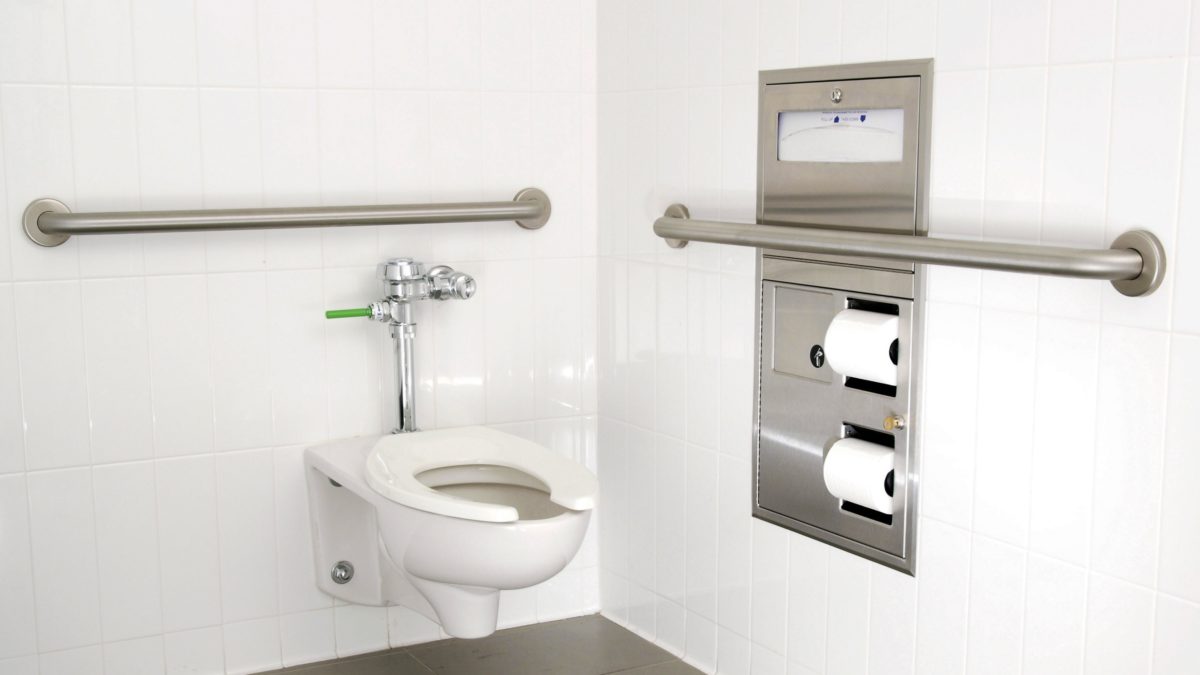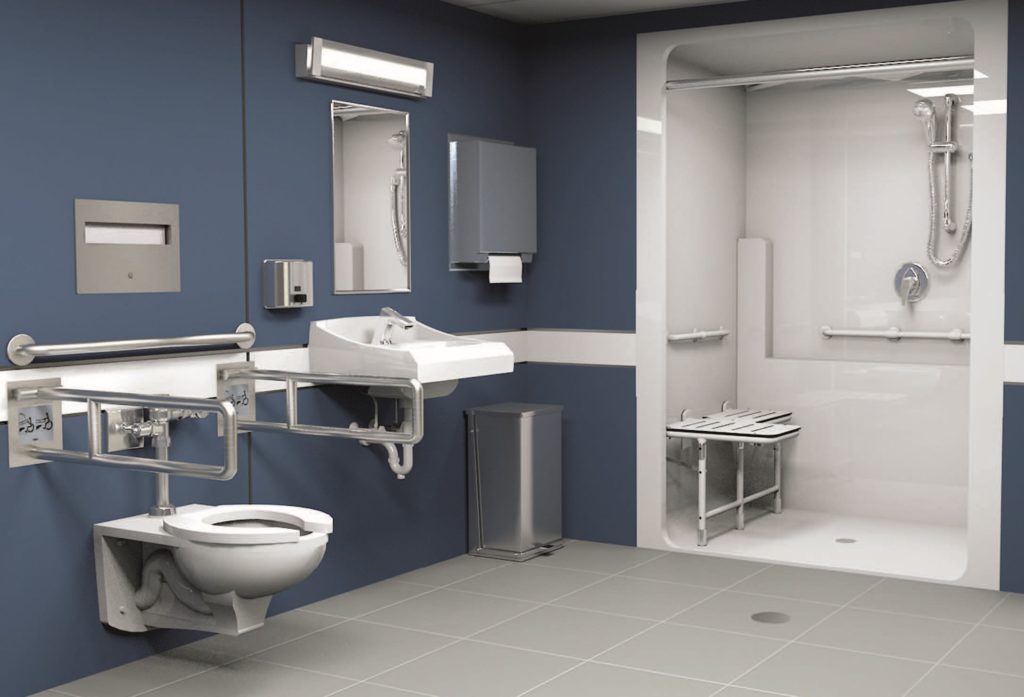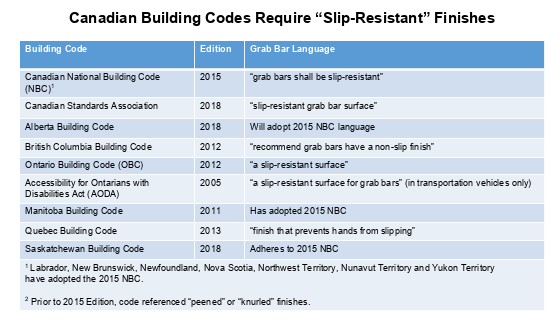Prevent more falls: Need-to-know code updates, new research on slip-resistant grab bar surfaces


by Alan Gettelman
Slips and falls are a serious patient safety issue facing healthcare facilities. According to an epidemiologic study conducted by the U.S. Department of Health and Human Services, falls occur at a rate of 3 to 5 per 1,000 bed-days. According to the Agency for Healthcare Research and Quality, 700,000 to 1 million hospitalized patients are injured from falls each year.
Areas within healthcare facilities that contain plumbing fixtures that may result in wet hands during use— sometimes called “wet” areas — amplify the risk of slips and falls for patients and staff. These areas include showers, bathtubs, patient bathrooms and areas adjacent to toilets. In fact, the heightened safety risks associated with wet hands are why both U.S. and Canadian building codes, including the American Disabilities Act (ADA) Standards for Accessible Design, mandate that grab bars be adjacent to these plumbing fixtures.
The role of a grab bar is to provide a secure place for a patient’s hand to grip as they access, use and leave a shower, bathtub or toilet, thereby preventing falls. Thus, those who design and specify products for healthcare facilities have an opportunity to enhance patient safety through their grab bar specifications.
In Canada specifically, the Canadian National Building Code (NBC) requires “slip-resistant” grab bar finishes in wet areas to provide additional traction. However, the code prior to 2015 included different language. Those seeking to enhance patient safety and satisfy (or exceed) this requirement should consider recent updates to the NBC as well as new testing data on grab bar finishes.
Slip-resistant grab bar surfaces
A slip-resistant grab bar surface can reduce the risk of a patient slipping or falling, thereby reducing the likelihood of injury, enhancing patient safety and reducing liability risk for facilities.
Slip-resistant grab bar finishes can also satisfy many national and provincial building codes in Canada. In the U.S., a slip-resistant grab bar surface would effectively exceed the ADA standard — to simply have grab bars installed in areas adjacent to plumbing fixtures.
Historically, architects designing wet areas have frequently specified peened- or knurled-finish grab bars to satisfy slip-resistance requirements. After all, peened- and knurled-finish grab bars, which feature textured surfaces, are typically marketed as slip-resistant. Further, the NBC prior to 2015 required “peened” or “knurled” finishes in the code language.
However, in 2018 new test data revealed that satin-finish grab bars can not only satisfy this requirement but also provide superior grip performance in wet areas. The ASTM F2961 Grip Performance Test, while not required by any building code, is a methodology that can provide a quantitative measurement of an individual’s ability to grip a solid object and twist in a defined direction. In September 2018, a test commissioned by Bobrick Washroom Equipment, Inc., and performed by Bureau Veritas Consumer Product Services, Inc., concluded that the slip-resistance of a satin-finish grab bar surface provides similar traction to a peened-finish grab bar when grabbed with a dry hand.
When grabbed with a wet hand, the surface of the satin-finish grab bar was found to provide 10 percent more traction than the surface of the peened-finish grab bar. For architects designing healthcare facilities, these new findings create new design opportunities.
Of course, slip-resistance is not the only consideration when it comes to specifying grab bars. In healthcare settings, hygiene is also a top priority. Accordingly, ease of cleaning is also a concern, and satin-finish surfaces are generally easier to clean compared to the somewhat rough, textured surface of peened and knurled finish grab bars.
Specifying a satin-finish grab bar surface can provide 10 percent more traction with a wet hand, while enhancing hygiene and reducing maintenance costs for healthcare facilities at the same time.
Canadian Building Code implications
As referenced earlier, the 2015 version of the Canadian National Building Code (NBC) requires grab bars have a “slip-resistant” finish. Meanwhile, individual provinces have either adopted the 2015 NBC grab bar surface requirement, or they have included similar language in their provincial building codes.
However, “slip-resistant” hasn’t always been the language contained in the code. Previously, building codes throughout Canada required “peened” or “knurled” grab bar surfaces. The reference to “a slip-resistant finish” is a major change, shifting the language from a type of grab bar surface (peened- or knurled-finish) to the resulting effect of the grab bar surface (slip-resistance).
Out of habit, many architects continue to specify grab bars with a “peened” or “knurled” finish. However, the new ASTM F2961 test data places “satin-finish” grab bars atop the consideration set—especially for healthcare facilities that must satisfy the 2015 NBC, 2018 Canadian Standards Association (CSA) or various provincial codes.
While slip-resistant surfaces are not required in wet areas in the U.S., ADA standards do require grab bars adjacent to plumbing fixtures—and the intent of that requirement should be considered in architect specifications. While the presence of grab bars satisfies the minimum standard, specifying a more slip-resistant grab bar for these applications exceeds the ADA requirement to provide added traction with a wet hand and supports universal or multigenerational design.
Specification language for slip-resistant grab bars
Architects specifying grab bars in wet areas of healthcare facilities should take care when crafting their specifications, avoid copying and pasting from previous projects and use appropriate language that reflects the most recent building codes.
While years of archived specifications from projects past might still read “peened” or “knurled” finish, “satin-finish, slip-resistant surface” can now be specified with confidence.
Alan Gettelman is vice president of external affairs at Bobrick Washroom Equipment, Inc. He is responsible for counseling on the preparation of architectural specifications and on fire codes, building codes and accessibility standards compliance. Gettelman can be reached via e-mail at agettelman@bobrick.com.

